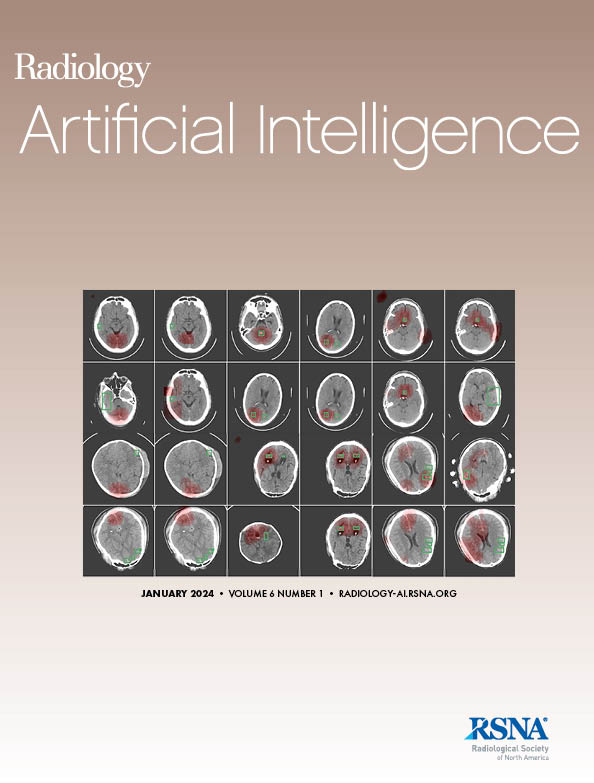Chen Chen, Jiabin Yu, Zhikang Xu, Changsong Xu, Zubang Zhou, Jindong Hao, Vicky Yang Wang, Jincao Yao, Lingyan Zhou, Chenke Xu, Mei Song, Qi Zhang, Xiaofang Liu, Lin Sui, Yuqi Yan, Tian Jiang, Yahan Zhou, Yingtianqi Wu, Binggang Xiao, Chenjie Xu, Hongmei Mi, Li Yang, Zhiwei Wu, Qingquan He, Jian Chen, Qi Liu, Dong Xu
求助PDF
{"title":"伪对比增强US通过增强生成对抗网络评估肿瘤消融疗效。","authors":"Chen Chen, Jiabin Yu, Zhikang Xu, Changsong Xu, Zubang Zhou, Jindong Hao, Vicky Yang Wang, Jincao Yao, Lingyan Zhou, Chenke Xu, Mei Song, Qi Zhang, Xiaofang Liu, Lin Sui, Yuqi Yan, Tian Jiang, Yahan Zhou, Yingtianqi Wu, Binggang Xiao, Chenjie Xu, Hongmei Mi, Li Yang, Zhiwei Wu, Qingquan He, Jian Chen, Qi Liu, Dong Xu","doi":"10.1148/ryai.240370","DOIUrl":null,"url":null,"abstract":"<p><p>Purpose To develop methods for creating pseudo-contrast-enhanced US (CEUS) by using an enhanced generative adversarial network and evaluate its ability to assess tumor ablation effectiveness. Materials and Methods This retrospective study included 1030 patients who underwent thyroid nodule ablation across seven centers from January 2020 to April 2023. A generative adversarial network-based model was developed for direct pseudo-CEUS generation from B-mode US and tested on thyroid, breast, and liver ablation datasets. The reliability of pseudo-CEUS was assessed using structural similarity index (SSIM), color histogram correlation, and mean absolute percentage error against real CEUS. Additionally, a subjective evaluation system was devised to validate its clinical value. The Wilcoxon signed rank test was employed to analyze differences in the data. Results The study included 1030 patients (mean age, 46.9 years ± 12.5 [SD]; 799 female and 231 male patients). For internal test set 1, the mean SSIM was 0.89 ± 0.05, while across external test sets 1-6, mean SSIM values ranged from 0.84 ± 0.08 to 0.88 ± 0.04. Subjective assessments affirmed the method's stability and near-realistic performance in evaluating ablation effectiveness. The thyroid ablation datasets had an average identification score of 0.49 (0.5 indicates indistinguishability), while the similarity average score for all datasets was 4.75 out of 5. Radiologists' assessments of residual blood supply were nearly consistent, with no differences in defining ablation zones between real and pseudo-CEUS. Conclusion The pseudo-CEUS method demonstrated high similarity to real CEUS in evaluating tumor ablation effectiveness. <b>Keywords:</b> Ablation Techniques, Ultrasound, Computer Applications-Virtual Imaging <i>Supplemental material is available for this article.</i> © RSNA, 2025.</p>","PeriodicalId":29787,"journal":{"name":"Radiology-Artificial Intelligence","volume":" ","pages":"e240370"},"PeriodicalIF":13.2000,"publicationDate":"2025-05-01","publicationTypes":"Journal Article","fieldsOfStudy":null,"isOpenAccess":false,"openAccessPdf":"","citationCount":"0","resultStr":"{\"title\":\"Pseudo-Contrast-enhanced US via Enhanced Generative Adversarial Networks for Evaluating Tumor Ablation Efficacy.\",\"authors\":\"Chen Chen, Jiabin Yu, Zhikang Xu, Changsong Xu, Zubang Zhou, Jindong Hao, Vicky Yang Wang, Jincao Yao, Lingyan Zhou, Chenke Xu, Mei Song, Qi Zhang, Xiaofang Liu, Lin Sui, Yuqi Yan, Tian Jiang, Yahan Zhou, Yingtianqi Wu, Binggang Xiao, Chenjie Xu, Hongmei Mi, Li Yang, Zhiwei Wu, Qingquan He, Jian Chen, Qi Liu, Dong Xu\",\"doi\":\"10.1148/ryai.240370\",\"DOIUrl\":null,\"url\":null,\"abstract\":\"<p><p>Purpose To develop methods for creating pseudo-contrast-enhanced US (CEUS) by using an enhanced generative adversarial network and evaluate its ability to assess tumor ablation effectiveness. Materials and Methods This retrospective study included 1030 patients who underwent thyroid nodule ablation across seven centers from January 2020 to April 2023. A generative adversarial network-based model was developed for direct pseudo-CEUS generation from B-mode US and tested on thyroid, breast, and liver ablation datasets. The reliability of pseudo-CEUS was assessed using structural similarity index (SSIM), color histogram correlation, and mean absolute percentage error against real CEUS. Additionally, a subjective evaluation system was devised to validate its clinical value. The Wilcoxon signed rank test was employed to analyze differences in the data. Results The study included 1030 patients (mean age, 46.9 years ± 12.5 [SD]; 799 female and 231 male patients). For internal test set 1, the mean SSIM was 0.89 ± 0.05, while across external test sets 1-6, mean SSIM values ranged from 0.84 ± 0.08 to 0.88 ± 0.04. Subjective assessments affirmed the method's stability and near-realistic performance in evaluating ablation effectiveness. The thyroid ablation datasets had an average identification score of 0.49 (0.5 indicates indistinguishability), while the similarity average score for all datasets was 4.75 out of 5. Radiologists' assessments of residual blood supply were nearly consistent, with no differences in defining ablation zones between real and pseudo-CEUS. Conclusion The pseudo-CEUS method demonstrated high similarity to real CEUS in evaluating tumor ablation effectiveness. <b>Keywords:</b> Ablation Techniques, Ultrasound, Computer Applications-Virtual Imaging <i>Supplemental material is available for this article.</i> © RSNA, 2025.</p>\",\"PeriodicalId\":29787,\"journal\":{\"name\":\"Radiology-Artificial Intelligence\",\"volume\":\" \",\"pages\":\"e240370\"},\"PeriodicalIF\":13.2000,\"publicationDate\":\"2025-05-01\",\"publicationTypes\":\"Journal Article\",\"fieldsOfStudy\":null,\"isOpenAccess\":false,\"openAccessPdf\":\"\",\"citationCount\":\"0\",\"resultStr\":null,\"platform\":\"Semanticscholar\",\"paperid\":null,\"PeriodicalName\":\"Radiology-Artificial Intelligence\",\"FirstCategoryId\":\"1085\",\"ListUrlMain\":\"https://doi.org/10.1148/ryai.240370\",\"RegionNum\":0,\"RegionCategory\":null,\"ArticlePicture\":[],\"TitleCN\":null,\"AbstractTextCN\":null,\"PMCID\":null,\"EPubDate\":\"\",\"PubModel\":\"\",\"JCR\":\"Q1\",\"JCRName\":\"COMPUTER SCIENCE, ARTIFICIAL INTELLIGENCE\",\"Score\":null,\"Total\":0}","platform":"Semanticscholar","paperid":null,"PeriodicalName":"Radiology-Artificial Intelligence","FirstCategoryId":"1085","ListUrlMain":"https://doi.org/10.1148/ryai.240370","RegionNum":0,"RegionCategory":null,"ArticlePicture":[],"TitleCN":null,"AbstractTextCN":null,"PMCID":null,"EPubDate":"","PubModel":"","JCR":"Q1","JCRName":"COMPUTER SCIENCE, ARTIFICIAL INTELLIGENCE","Score":null,"Total":0}
引用次数: 0
引用
批量引用

 求助内容:
求助内容: 应助结果提醒方式:
应助结果提醒方式:


